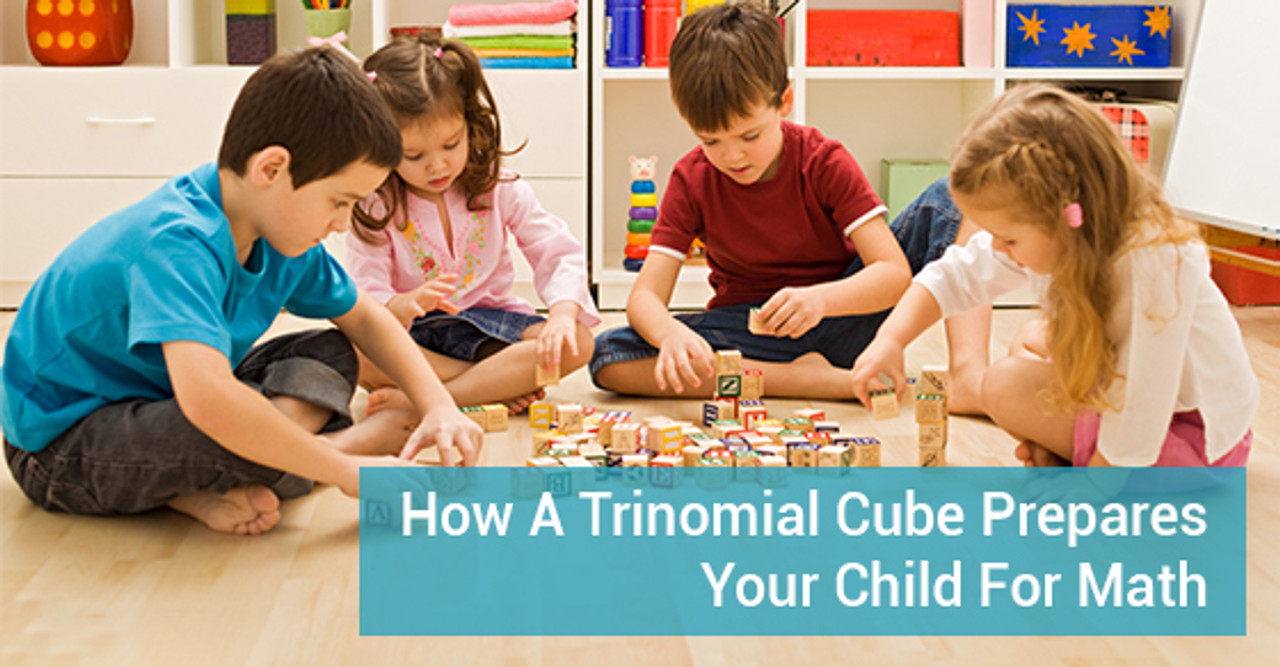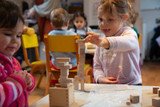How A Trinomial Cube Prepares Your Child For Math
Children love puzzles, games, and really anything they have to figure out. Colourful and intriguing, the Trinomial Cube is a particular favourite within the Montessori environment. Children see it as a game and a challenge, so they’re having fun while simultaneously shifting the way they conceptualize mathematics through spatial positioning.
Once unhinged, the cube reveals over twenty colourful prisms that can be moved and stacked outside and inside the box. This cube's name comes from the fact that, once it is assembled, it forms the cube of a trinomial, which is an algebraic expression that uses three terms. While the direct goal is to simply put the cube back together, the process indirectly affects children's fine motor skills, cognitive skills, social skills, and problem-solving, including spatial reasoning.
How it Works
The trinomial cube piques interest first with its colourful container. On the top of the box is the square of the trinomial, painted red, blue, yellow, and black. The lid serves as a key to the puzzle. The prisms and cubes that comprise the puzzle are encased in this hinged box. Two sides of the box pull down, and, if the cube isn't properly assembled, the box won't close.
The box contains 27 pieces, aside from the box and the lid. Included are three cubes of varying sizes: one red, one blue, and one yellow. Eighteen of these pieces are square-based prisms, six red and black, six blue and black, and six yellow and black. The remaining six pieces are black rectangular-based prisms which correspond to the edges of the three cubes.
There are three layers to the cube, each layer consisting of eight prisms and one cube. The bottom layer is the tallest layer and contains the red cube. The second layer is slightly shorter and contains the blue cube. The topmost layer is the shortest and contains the yellow cube.
There are many ways you can assemble the blocks outside of the box as a means of experiencing math sensorially. When stacked one way, you can see how every layer of blocks is the same height; when stacked another way, you can see how each layer is increasingly smaller than the last.
If you get lost, the lid serves as your key. However, the more challenging you want the activity to be, the less you should use the lid for direction. All of this building and deconstruction is in the attempt to visually conceptualize the proof of the formula (a+b+c)³.
The Cube and the Trinomial Theorem
The Trinomial Cube is based on the trinomial theorem (a+b+c)³.
When condensed, you have three variables to consider: a, b, and c. When expanded, the equation looks a little more like this:
a3 + 3a2b + 3a2c + b3 + 3ab2 + 3b2c + c3 + 3ac2 + 3bc2 + 6abc.
The cube is the expanded version.
Each piece of the puzzle is a small part of the theorem; the colours help to differentiate the squares and cubes of those parts:
- The red cube represents a3. Every red and black prism represents the component a2 when paired with b or c.
- The blue cube represents b3. Every blue and black prism represents the component b2 when paired with a or c.
- The yellow cube represents c3. Every yellow and black prism represents the component c2 when paired with a or b.
- Lastly, all six black prisms represent the component abc.
In assembling this cube, you find that the red and black prisms stack around the red cube, the blue and black prisms stack around the blue cube, and the yellow and black prisms stack around the yellow cube. Strictly black prisms fill in the empty spaces.
This cube helps shape the way you look at the mathematical world. Children will be able to see the world as a third-dimensional space which is built on mathematics. Seeing and working with this box of prisms helps children build upon their current understanding of math.
Puzzles Aid in Spatial Development
Puzzles like this cube are designed with both a direct and an indirect goal for the child's natural development. Like with any puzzle, the direct goal for the child is simply to solve the puzzle. The indirect goal for completing the puzzle is for the child to be exposed to the concepts of algebra and the aforementioned trinomial theorem.
Researchers from the University of Chicago found that children between the ages of two and four who played with puzzles would be more likely to develop better spatial skills than their non-puzzle playing counterparts. These puzzle-playing children have a better grasp on how objects move in space, thus they have a better understanding of the spatial and mathematical.
Challenging children with the completion of the cube has many benefits which prepare them for math. These benefits include:
- Aids in fine motor development
Most don't realize the vast number of objects adults have learned to work with every day. Assembling and disassembling the box full of prisms helps better develop the fine motor skills including hand-eye coordination. The application of mathematics often requires movement, even something as little as dragging a pencil over paper.
- Teaches cognitive skills
Children who solve puzzles like this cube of trinomials learn about the spatial and colour differentiation. Perhaps most important cognitively, you exercise your memory when working with the colourful prisms. Memory revolves around recalling the pieces and failed attempts in order to learn from trial and error.
- Teaches problem-solving skills
The step-by-step method of solving the cube presents children with a goal: to solve the cube. Children learn to follow directions in order to reach that goal. The lid to the cube serves as the directions, but only once combined with the exploration of the cube.
- To learn, you need to finish
It can be frustrating, but challenges aren’t meant to be easy. As you deconstruct the cube one layer at a time, you see how the cube is built and, thus, all the steps you need to reassemble the puzzle.
- You will develop problem-solving skills
You may need help when solving the trinomial cube, but it's all part of the learning process. Sometimes we need interaction to learn, which is why learned social skills are also important.
- It will teach social skills
The goal of the cube is to reassemble it accordingly. This can be a difficult task. Everyone needs help learning sometimes, and learning to take direction and communicate about shapes and numbers, along with learning patience through sharing and taking turns, is important for any child learning math.
You live in the third dimension, so it’s only logical to broaden your spatial intelligence. Math is a scary topic for children and adults, but solving puzzles like the trinomial cube can help you and your child broaden your understanding of the math that the world you know is built on. The colourful cube intrigues children, provides a goal, and encourages them to better their cognitive and problem-solving skills through puzzle play.
To find out how to give your child’s education a boost, call Thinkamajigs today at 800-363-3013 or contact us here.
LATEST BLOG POSTS
How To Set Up A Montessori Environment At Home
Creating a Montessori-inspired environment at home provides the opportunity to support your child's...
Montessori & Technology: do they play well together?
Dr. Maria Montessori’s method of teaching children emphasizes the use of concrete materials and hand...
Froebel Gifts: An Introduction
You may have heard of Fröebel Gifts (we carry the full selection here), but you may also wonder what...
Safe Toys for Toddlers: What Parents Should Know
As a parent, you want to be sure that any toys your toddler plays with are safe and age-appropriate....
Infant & Toddler Toy Guide - Part 2
THINKAMAJIGS’ GUIDE TO CHOOSING EDUCATIONAL TOYS FROM BIRTH TO AGE 3PART 2: AGE-RELATED DEVELOPMENTA...
Infant & Toddler Toy Guide - Part 1
THINKAMAJIGS’ GUIDE TO CHOOSING EDUCATIONAL TOYS FROM BIRTH TO AGE 3PART 1: SKILLS DEVELOPMENT“What...







